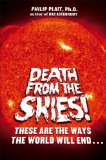
 Phil Plait has a new book out, Death from the Skies!: These Are the Ways the World Will End . . .
Phil Plait has a new book out, Death from the Skies!: These Are the Ways the World Will End . . ., and it is all about the end of the world and death of all humans. Phil is the author of the Bad Astronomy blog and recently took over as head of JREF, the James Randi Educational Foundation, the funnest skeptic’s organization on the planet. Since Phil is a Ph.D. scientist he takes a different approach than you might expect from end-of-the-world movie plots. With each chapter Phil opens with a story about the disaster as a normal human being would see it unfold, then he goes to explain exactly what would happen if that disaster actually occurred and what, if anything, we humans could do to avoid it. (In most cases, the answer is, sadly, nothing.)
The book opens up with the classic asteroid-impact-ending-all-life-on-earth, then goes on to supernovas, black holes, the old-age death of the universe itself, and even alien encounters. While this all might sound a little grim, Phil keeps it upbeat and focuses on the science, so while reading the chapter on supernovas, for example, you learn a lot about how supernovas and stars operate. For example, did you know Sirus, a nearby neighbor star, is a binary system destined to likely become a Type I supernova, wiping out all life on earth? (It’s OK though, it probably won’t happen for tens of millions of years. Probably.)
For GeekDads this is an entertaining book just for personal reading, but high-school geeklets would likely enjoying reading through it as well. It’s a solid, easy-to-read popular science book in the spirit of Sagan’s The Demon-Haunted World or Shermer’s Why People Believe Weird Things
. You might think of this as a stealth education book. The end-of-the-world hook draws you in, but you find all sorts of useful knowledge inside.
At the end of the book Phil discusses the statistical chances of any of these events happening. He includes charts and tables so you can compare your chances for survival. Fortunately, all of them are pretty unlikely, but that probably won’t stop you from feeling just a little worried the next time you see a shooting star.
![Reblog this post [with Zemanta]](http://img.zemanta.com/reblog_e.png?x-id=bde09145-931a-47c4-acf6-a4283ee05ed2)


